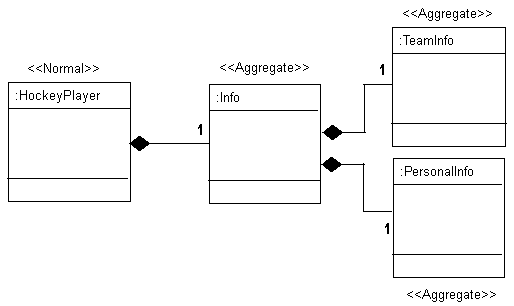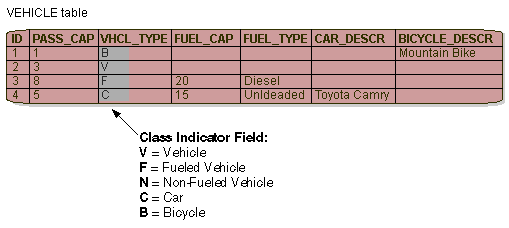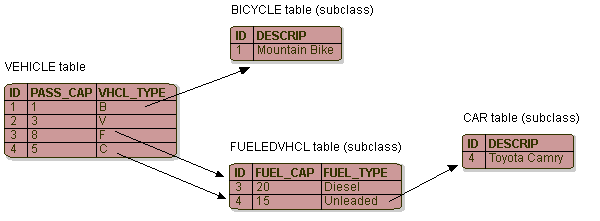Notice: This Wiki is now read only and edits are no longer possible. Please see: https://gitlab.eclipse.org/eclipsefdn/helpdesk/-/wikis/Wiki-shutdown-plan for the plan.
Introduction to Relational Descriptors (ELUG)
Contents
For information on descriptor concepts and features common to more than one type of EclipseLink descriptors, see Introduction to Descriptors.
Relational descriptors describe Java objects that you map to tables in a relational database. You use them in relational projects.
Using relational descriptors in a relational project, you can configure relational mappings.
For more information, see the following:
Aggregate and Composite Descriptors in Relational Projects
In a relational project, you can designate the descriptor as an aggregate.
This lets you configure an aggregate mapping to associate data members in the target object with fields in the source object's underlying database tables.
When you designate a relational descriptor as an aggregate, EclipseLink lets you specify a mapping type for each field in the target class, but defers associating the field with a database table until you configure the aggregate object mapping in the source descriptor. In other words, the target class descriptor defines how each target class field is mapped, but the source class descriptor defines where each target class field is mapped. This lets you share an aggregate object among many parent descriptors mapped to different tables.
When you designate a relational descriptor as an aggregate, you tell EclipseLink that the class will be a target of an aggregate object mapping, and this ensures that the EclipseLink runtime handles the target class as follows:
- It inserts, updates, and deletes the target class in parallel with its source class.
- It does not cache the target class on its own; instead, it caches the target class as part of its source class.
- It does not allow the target class to be read, written, deleted, or registered in a unit of work.
When working with aggregate relational descriptors, consider the following:
For more information, see Configuring a Relational Descriptor as a Class or Aggregate Type.
Relational Aggregates and Nesting
EclipseLink supports nested aggregates. In the Nested Aggregates figure, source class HockeyPlayer is a normal nonaggregate class descriptor. It owns target class Info which is designated as an aggregate. The Info class itself owns target classes PersonalInfo and TeamInfo which are each designated as aggregates.
Nested Aggregates
In EJB 3.0, an aggregate is known as an embeddable. In the EJB 3.0 specification, an embeddable may not contain another embeddable (that is, the EJB 3.0 specification does not support nested aggregates).
However, if you deploy an EclipseLink-enabled EJB 3.0 application with persistence to OC4J, you can take advantage of an EclipseLink extension of the EJB 3.0 specification to configure nested embeddables. Note that if you do so, your application will not be strictly EJB 3.0-compliant. The Nested Embeddables example shows the classes from the Nested Aggregates figure, using EJB 3.0 annotations to take advantage of the EclipseLink extension of the EJB 3.0 specification to allow Info (an embeddable) to own embeddables TeamInfo and PersonalInfo.
Nested Embeddables
public class HockeyPlayer implements Serializable { private int playerId; private Info Info; private String lastName; private String firstName; ... @Embedded public Info getInfo() { return Info; } } @Embeddable public class Info implements Serializable { TeamInfo teamInfo; // EclipseLink extension of EJB 3.0 allows Embeddable with Embeddable PersonalInfo personalInfo; public Info() {} @Embedded public PersonalInfo getPersonalInfo() { return personalInfo; } public void setPersonalInfo(PersonalInfo personalInfo) { this.personalInfo = personalInfo; } @Embedded public TeamInfo getTeamInfo() { return teamInfo; } public void setTeamInfo(TeamInfo teamInfo) { this.teamInfo = teamInfo; } } @Embeddable public class PersonalInfo implements Serializable { private int age; private double weight; private double height; ... } @Embeddable public class TeamInfo implements Serializable { private String position; private int jerseyNumber; private HockeyTeam hockeyTeam; ... }
Relational Aggregates and Inheritance
You can configure inheritance for a relational descriptor designated as an aggregate (see Descriptors and Inheritance), however, in this case, all the descriptors in the inheritance tree must be aggregates. Aggregate and class descriptors cannot exist in the same inheritance tree.
Descriptors and Inheritance in Relational Projects
Inheritance describes how a derived class inherits the characteristics of its superclass. You can use descriptors to describe the inheritance relationships between classes in your relational projects.
This section includes information on the following topics:
- Inheritance and Primary Keys in Relational Projects
- Single- and Multi-Table Inheritance in Relational Projects
For more information, see Descriptors and Inheritance.
Inheritance and Primary Keys in Relational Projects
For relational projects, EclipseLink assumes that all of the classes in an inheritance hierarchy have the same primary key, as set in the root descriptor. Child descriptors associated with data source representations that have different primary keys must define the mapping between the root primary key and the local one.
For more information, see Configuring Primary Keys.
Single- and Multi-Table Inheritance in Relational Projects
In a relational project, you can map your inheritance hierarchy to a single table or to multiple tables. Use these options to achieve the balance between storage efficiency and access efficiency that is appropriate for your application.
Single-Table Inheritance
In this example, you store classes with multiple levels of inheritance in a single table to optimize database access speeds.
The entire inheritance hierarchy shown in the Nested Aggregates figure can share the same table, as in the Inheritance Using a Superclass Table with Optional Fields figure. The FueledVehicle and NonFueledVehicle subclasses can share the same table even though FueledVehicle has some attributes that NonFueledVehicle does not. The NonFueledVehicle instances waste database resources because the database must still allocate space for the unused portion of its row. However, this approach saves on accessing time because there is no need to join to another table to get the additional FueledVehicle information.
As this figure shows, this approach uses a class indicator field. For more information, see How to Specify a Class Indicator.
Inheritance Using a Superclass Table with Optional Fields
Multi-Table Inheritance
In this example, you store classes with multiple levels of inheritance in multiple tables to optimize database storage space.
In the inheritance hierarchy shown in the Nested Aggregates figure, for subclasses that require additional attributes, you use multiple tables instead of a single superclass table. This optimizes storage space because there are no unused fields in the database. However, this may affect performance because EclipseLink must read from more than one table before it can instantiate the object. EclipseLink first looks at the class indicator field to determine the class of object to create, then uses the descriptor for that class to read from the subclass tables.
The Inheritance Using Separate Tables for Each Subclass figure illustrates the EclipseLink implementation of the FUELEDVHCL, CAR, and BICYCLE tables. All objects are stored in the VEHICLE table. FueledVehicle, Car, and Bicycle information are also stored in secondary tables. Note that because the NonFueledVehicle class does not hold any attributes or relationships, it does not need a secondary table.
Inheritance Using Separate Tables for Each Subclass
|
Note: In general, using multitable inheritance is inefficient because it can require excessive joins and multiple table fetching. |
Inheritance Outer-Joins
If a root or branch inheritance descriptor has subclasses that span multiple tables, you can configure a database view to optimize the performance of queries against the parent descriptor by outer-joining all of the subclass tables. This allows EclipseLink to fetch all of the subclass instances in one query, instead of multiple queries. It also allows queries for the parent class that use cursors or ordering.
By default, EclipseLink executes multiple queries to read in a multiple table inheritance hierarchy, which, in some cases, is the most efficient way to query. In addition, EclipseLink supports querying the inheritance hierarchy using a single outer-join query.
You can also set a database view on the descriptor that outer-joins or unions all of the tables. For more information, see Configuring Multitable Information.



